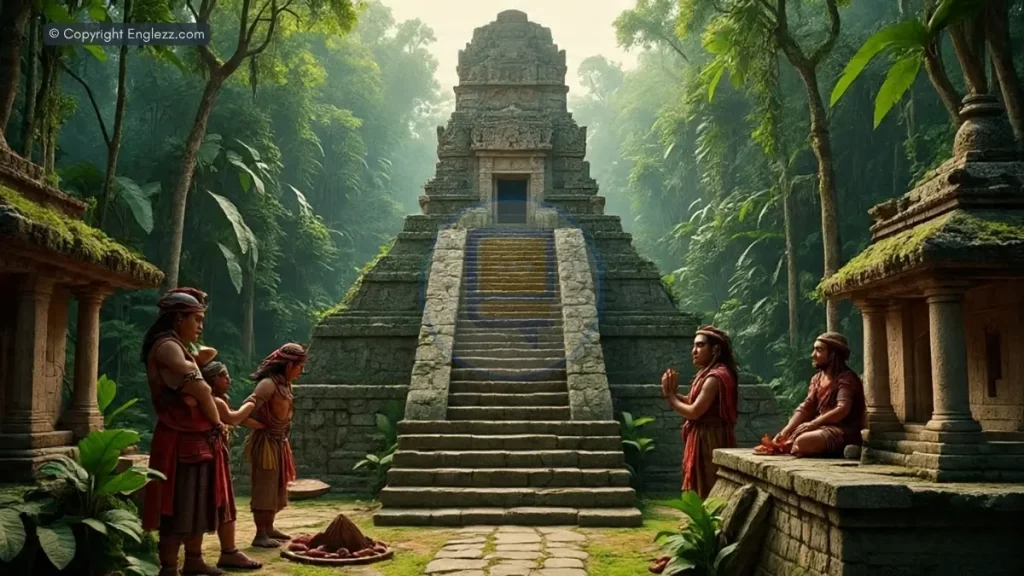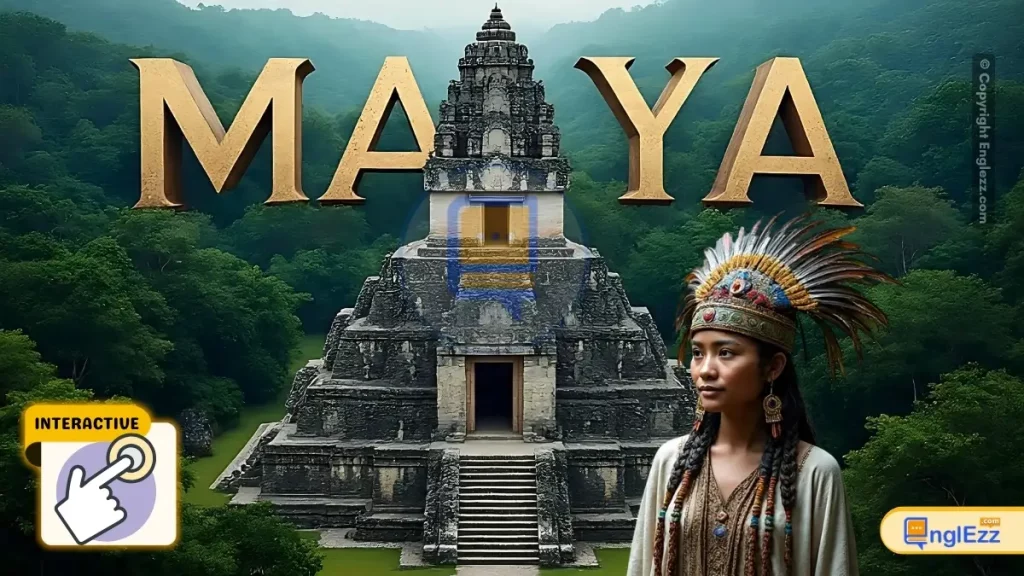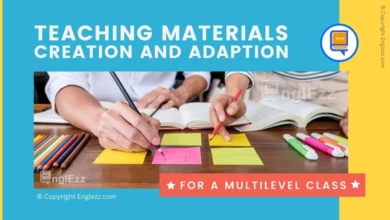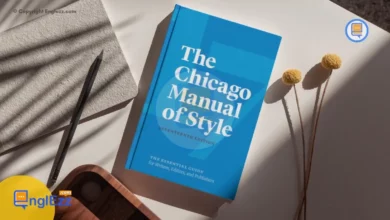
The Story of Maya Civilization
From Ancient Cities to Modern Rediscovery
Introduction
The Maya Journey
The Maya civilization was one of the most dominant indigenous societies of Mesoamerica. Unlike other scattered indigenous populations of Mesoamerica, the Maya were centered in one geographical block covering all of the Yucatan Peninsula and modern-day Guatemala, Belize, parts of the Mexican states of Tabasco and Chiapas, and the western part of Honduras and El Salvador.
The Maya excelled at agriculture, pottery, hieroglyph writing, calendar-making, mathematics, and were one of the few ancient civilizations to develop a fully-fledged writing system. Their architecture included temples, pyramids, palaces, and observatories, all built without metal tools. The Maya were skilled weavers and potters, and they cleared routes through jungles and swamps to foster extensive trade networks.
Preclassic Period
The Preclassic period (2000 BCE – 250 CE) saw the foundations of Maya civilization with the development of agriculture, early villages, and the first ceremonial centers. During this time, the Maya developed their distinctive artistic and architectural styles, as well as early forms of writing and calendrical systems.
Classic Period
The Classic period (250-900 CE) was the golden age of the Maya civilization, marked by the construction of great cities like Tikal, Palenque, and Copán. During this time, the Maya made significant advances in mathematics, astronomy, and writing. The population grew dramatically, and a complex system of city-states with divine kings emerged.
Modern Rediscovery
After centuries of obscurity, the Maya civilization was rediscovered in the 19th century. Modern archaeology has revealed the sophistication of Maya culture, including their advanced calendar system, astronomical knowledge, and complex political systems. Today, millions of Maya people continue to live in their ancestral homelands, preserving many cultural traditions.
Interactive Maya Civilization Timeline
Early Maya Settlements
The first permanent Maya villages appear in the highlands and lowlands, marking the beginning of settled agricultural life.
Read moreAround 2000 BCE, the Maya people began transitioning from a nomadic hunter-gatherer lifestyle to settled agricultural communities. This shift was made possible by the domestication of maize (corn), beans, squash, and other crops that formed the basis of the Maya diet.
Early Maya villages were typically small, consisting of thatched huts built around central plazas. These communities practiced slash-and-burn agriculture, clearing forest areas for cultivation. The fertile volcanic soils of the highlands and the rich alluvial soils of the lowlands supported this agricultural revolution.
During this period, the Maya began developing their distinctive cultural traits, including early forms of pottery and religious practices that would evolve into the complex belief system of later periods. The earliest known Maya pottery dates to about 1900 BCE from sites in the Pacific coastal region.
Further Reading
- Sharer, Robert J. The Ancient Maya (2006)
- Coe, Michael D. The Maya (2011)
Olmec Influence
The Maya come under the cultural influence of the Olmec civilization, adopting aspects of their art, religion, and political organization.
Read moreAround 1000 BCE, the Maya began interacting with the Olmec civilization, often considered the “mother culture” of Mesoamerica. The Olmec, centered in the Gulf Coast region, exerted significant influence on early Maya society through trade and cultural exchange.
The Maya adopted several key elements from the Olmec, including:
- Jaguar imagery in art and religion
- Ballgame rituals
- Early forms of writing and calendrical systems
- Monumental architecture and sculpture
This period saw the construction of the first Maya ceremonial centers, such as Nakbé and El Mirador in the Petén region. These sites featured large platforms and pyramids, foreshadowing the grand architecture of the Classic period.
Further Reading
- Diehl, Richard A. The Olmecs: America’s First Civilization (2004)
- Pool, Christopher A. Olmec Archaeology and Early Mesoamerica (2007)
Classic Period Begins
The Maya Classic period begins, marked by the rise of powerful city-states and the flourishing of Maya art, architecture, and writing.
Read moreThe Classic period (250-900 CE) represents the peak of Maya civilization, characterized by the construction of monumental architecture, the development of a sophisticated writing system, and significant advances in mathematics and astronomy.
During this time, the Maya lowlands were divided into numerous independent city-states, each ruled by a divine king (k’uhul ajaw). These city-states engaged in complex political relationships, including alliances, trade networks, and warfare. Major cities included Tikal, Calakmul, Palenque, Copán, and Caracol.
The Classic period saw the construction of iconic Maya structures such as stepped pyramids, ball courts, and elaborate palaces. The Maya developed a complex calendar system that included the 260-day sacred calendar (Tzolk’in) and the 365-day solar calendar (Haab’), which they combined into the Calendar Round.
Further Reading
- Martin, Simon, and Nikolai Grube. Chronicle of the Maya Kings and Queens (2008)
- Schele, Linda, and David Freidel. A Forest of Kings (1990)
Reign of Jasaw Chan K’awiil I
The great ruler Jasaw Chan K’awiil I ascends to the throne of Tikal, marking a resurgence of the city’s power.
Read moreJasaw Chan K’awiil I (r. 682-734 CE) was one of Tikal’s most successful rulers, restoring the city’s prominence after a period of decline. His reign marked a turning point in Tikal’s history and the broader political landscape of the Maya lowlands.
Key achievements of his reign include:
- Victory over Calakmul in 695 CE, ending Tikal’s subordination to its rival
- Construction of Temple I (the Temple of the Great Jaguar), his funerary pyramid
- Revitalization of Tikal’s economy and political influence
- Commissioning of numerous stelae recording his achievements
Jasaw Chan K’awiil’s reign exemplifies the divine kingship system of the Classic period, where rulers were seen as intermediaries between the human and supernatural realms. His funerary temple remains one of the most iconic structures at Tikal.
Further Reading
- Harrison, Peter D. The Lords of Tikal: Rulers of an Ancient Maya City (1999)
- Webster, David L. The Fall of the Ancient Maya (2002)
Classic Maya Collapse
The southern lowland cities are abandoned, marking the end of the Classic period and the beginning of the Postclassic.
Read moreBetween 800-900 CE, the great Maya cities of the southern lowlands experienced a dramatic decline and were largely abandoned. This “Maya Collapse” remains one of archaeology’s greatest mysteries, with multiple factors likely contributing to the downfall.
Possible causes include:
- Environmental degradation and drought
- Overpopulation straining resources
- Political instability and warfare
- Disruption of trade networks
- Peasant revolts against the elite
While the southern cities were abandoned, Maya civilization continued in the northern Yucatán Peninsula, where cities like Chichen Itza, Uxmal, and Mayapán flourished during the Postclassic period (900-1521 CE). The collapse was not the end of the Maya people, but rather a transformation of their political and cultural systems.
Further Reading
- Diamond, Jared. Collapse: How Societies Choose to Fail or Succeed (2005)
- Demarest, Arthur A. Ancient Maya: The Rise and Fall of a Rainforest Civilization (2004)
Rise of Mayapán
Mayapán becomes the dominant political power in the Yucatán Peninsula, establishing a regional hegemony.
Read moreFollowing the decline of Chichen Itza around 1100 CE, Mayapán emerged as the most powerful city in the northern Yucatán Peninsula. For about 250 years (1200-1450 CE), Mayapán dominated the region through a combination of military force and political alliances.
Key features of Mayapán’s hegemony:
- Governed by the Cocom dynasty in alliance with other noble families
- Controlled territory through a system of provincial governors
- Maintained a standing army to enforce its rule
- Continued many Classic period traditions while adapting to new circumstances
The city itself was densely populated, with an estimated 12,000 inhabitants living within its walls. Mayapán’s architecture, while smaller in scale than Classic period cities, followed similar patterns with pyramids, temples, and palaces arranged around plazas.
Mayapán’s dominance ended around 1441-1461 CE with a revolt led by the Xiu family, which fragmented political power in the Yucatán just before Spanish contact.
Further Reading
- Masson, Marilyn A., and Carlos Peraza Lope. Kukulcan’s Realm: Urban Life at Ancient Mayapán (2014)
- Ringle, William M. The Political Geography of Mayapán (2009)
Spanish Conquest Begins
Spanish conquistadors led by Pedro de Alvarado begin their invasion of the Maya highlands.
Read moreIn 1524, Pedro de Alvarado, one of Hernán Cortés’ lieutenants, led Spanish forces into the Maya highlands of what is now Guatemala. This marked the beginning of the Spanish conquest of the Maya region, which would continue for over 170 years until the fall of the last independent Maya kingdom in 1697.
The conquest was characterized by:
- Military campaigns against Maya city-states
- Exploitation of existing rivalries between Maya groups
- Introduction of European diseases that devastated the population
- Forced conversion to Christianity and suppression of Maya religion
Despite Spanish technological advantages, Maya resistance was fierce and prolonged. The Itza Maya of the Petén region maintained their independence until 1697, nearly two centuries after Columbus’s first voyage to the Americas.
The conquest had devastating consequences for the Maya, including population decline, cultural disruption, and the burning of countless Maya books by Spanish priests who viewed them as pagan works.
Further Reading
- Restall, Matthew. Seven Myths of the Spanish Conquest (2003)
- Jones, Grant D. The Conquest of the Last Maya Kingdom (1998)
Stephens & Catherwood Expeditions
John Lloyd Stephens and Frederick Catherwood begin their explorations of Maya ruins, introducing them to the Western world.
Read moreAmerican diplomat John Lloyd Stephens and English artist Frederick Catherwood conducted two major expeditions to Maya ruins (1839-1840 and 1841-1842), documenting sites such as Copán, Palenque, and Uxmal. Their publications, including Incidents of Travel in Central America, Chiapas, and Yucatan, brought worldwide attention to the Maya civilization.
Their work was significant because:
- Catherwood’s detailed illustrations provided accurate representations of Maya art and architecture
- Stephens correctly identified the ruins as products of the ancestors of the contemporary Maya
- Their books sparked scientific and public interest in Maya archaeology
- They documented sites that have since been damaged or destroyed
Stephens and Catherwood’s work marked the beginning of modern Maya archaeology and helped dispel racist notions that indigenous peoples could not have built such sophisticated structures.
Further Reading
- Stephens, John Lloyd. Incidents of Travel in Central America, Chiapas, and Yucatan (1841)
- Von Hagen, Victor W. Maya Explorer: John Lloyd Stephens and the Lost Cities of Central America and Yucatan (1947)
Discovery of Pakal’s Tomb
Archaeologist Alberto Ruz Lhuillier discovers the tomb of King Pakal in the Temple of the Inscriptions at Palenque.
Read moreIn 1952, Mexican archaeologist Alberto Ruz Lhuillier made one of the most spectacular discoveries in Maya archaeology—the intact tomb of K’inich Janaab’ Pakal (Pakal the Great), the 7th-century ruler of Palenque, buried deep within the Temple of the Inscriptions.
The discovery was significant because:
- It confirmed that Maya pyramids served as royal tombs as well as temples
- The elaborate sarcophagus lid became an iconic image of Maya art
- The tomb contained rich offerings including jade artifacts and a mosaic death mask
- Hieroglyphic inscriptions provided detailed information about Pakal’s life and reign
Pakal ruled Palenque from 615 to 683 CE, overseeing a period of great architectural and artistic achievement. His tomb, hidden beneath the pyramid, remained undisturbed for over 1,200 years until its discovery, which revolutionized understanding of Maya funerary practices and royal ideology.
Further Reading
- Ruz Lhuillier, Alberto. El Templo de las Inscripciones: Palenque (1973)
- Schele, Linda, and Peter Mathews. The Code of Kings: The Language of Seven Sacred Maya Temples and Tombs (1998)
Maya Civilization Quiz
Test Your Knowledge of Maya History
Frequently Asked Questions
Common Questions About Maya Civilization
The collapse of the Classic Maya civilization (c. 800-900 CE) was likely caused by a combination of factors:
- Environmental factors: Prolonged droughts and deforestation may have led to agricultural failure
- Overpopulation: The strain on resources from growing populations
- Political instability: Warfare between city-states and challenges to royal authority
- Economic disruption: Breakdown of trade networks
- Social upheaval: Possible peasant revolts against the elite
It’s important to note that the “collapse” mainly affected the southern lowland cities. Maya civilization continued in the northern Yucatán and highland regions, and millions of Maya people survive today.
No, this was a misinterpretation of the Maya Long Count calendar. The calendar cycle that ended on December 21, 2012 (13.0.0.0.0 in the Long Count) simply marked the completion of a 5,125-year cycle (a “baktun”) and the beginning of a new one, much like our calendar rolls over from December 31 to January 1.
Ancient Maya inscriptions show they envisioned time as cyclical rather than linear, with cycles of creation and renewal. There is no evidence the Maya believed the world would end in 2012—this idea came from modern misinterpretations and sensationalism.
In fact, some Maya texts mention events predicted to occur after 2012, showing they expected the world to continue beyond that date.
The Maya made numerous significant advances, including:
- Mathematics: Developed the concept of zero and a vigesimal (base-20) number system
- Astronomy: Created precise calendars and tracked planetary movements
- Writing: Developed the most sophisticated writing system in the Americas
- Architecture: Built impressive cities with pyramids, temples, and palaces
- Art: Produced beautiful sculptures, murals, and ceramics
- Agriculture: Developed advanced techniques like terracing and raised fields
Many of these achievements were made independently of influence from other world civilizations.
Yes, there are approximately 7 million Maya people living today in their ancestral homelands across southern Mexico, Guatemala, Belize, Honduras, and El Salvador. They speak over 30 different Maya languages and maintain many cultural traditions, including:
- Traditional clothing and weaving
- Agricultural practices
- Religious syncretism blending Catholicism with traditional beliefs
- Healing practices and herbal medicine
- Ceremonies and festivals with pre-Columbian roots
While they have faced centuries of discrimination and marginalization, Maya communities continue to preserve their cultural heritage and advocate for their rights.
Conclusion
The Maya Legacy
The Maya civilization represents one of the most sophisticated and enduring cultures of the ancient world. From their beginnings as agricultural villages to their magnificent city-states, the Maya developed complex systems of writing, mathematics, astronomy, and governance that continue to impress scholars today.
While the Classic period collapse marked a transformation of Maya society, it was not the end of the Maya people. Today, millions of Maya maintain their cultural identity, language, and traditions, even as they navigate the challenges of the modern world.
Maya Civilization Key Takeaways
Preclassic Foundations
The Preclassic period saw the development of agriculture, early villages, and ceremonial centers that laid the foundation for Maya civilization.
Classic Achievements
The Classic period was the golden age of Maya civilization, marked by great cities, advances in science and art, and a complex political system.
Postclassic Transformation
After the southern collapse, Maya civilization continued in the north with new centers of power and cultural adaptations.
Spanish Contact
The Spanish conquest brought devastation but failed to erase Maya culture, which survived despite centuries of oppression.
Modern Rediscovery
Archaeological discoveries and the decipherment of Maya writing have revealed the sophistication of this ancient civilization.
The study of Maya civilization reminds us of the incredible achievements possible in human societies, as well as the fragility of even the most powerful civilizations. As we continue to uncover the secrets of the ancient Maya, we gain not only historical knowledge but also perspective on our own place in the long arc of human history.
Recommended Reading About Maya Civilization
- Coe, Michael D. The Maya (9th edition, 2015)
- Sharer, Robert J., and Loa P. Traxler. The Ancient Maya (6th edition, 2006)
- Martin, Simon, and Nikolai Grube. Chronicle of the Maya Kings and Queens (2nd edition, 2008)
- Restall, Matthew, and Amara Solari. 2012 and the End of the World: The Western Roots of the Maya Apocalypse (2011)
- Tedlock, Dennis (trans.). Popol Vuh: The Mayan Book of the Dawn of Life (revised edition, 1996)









